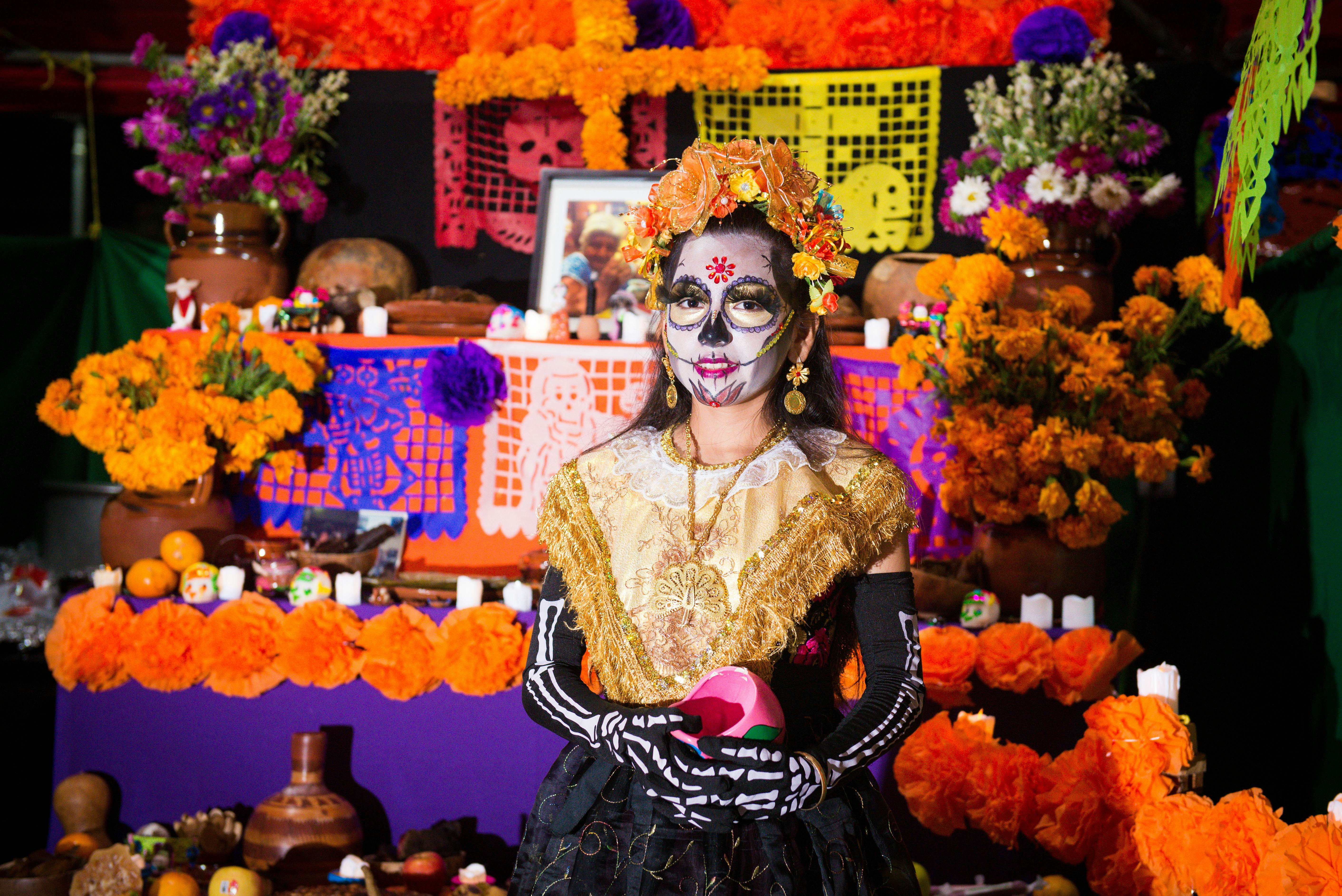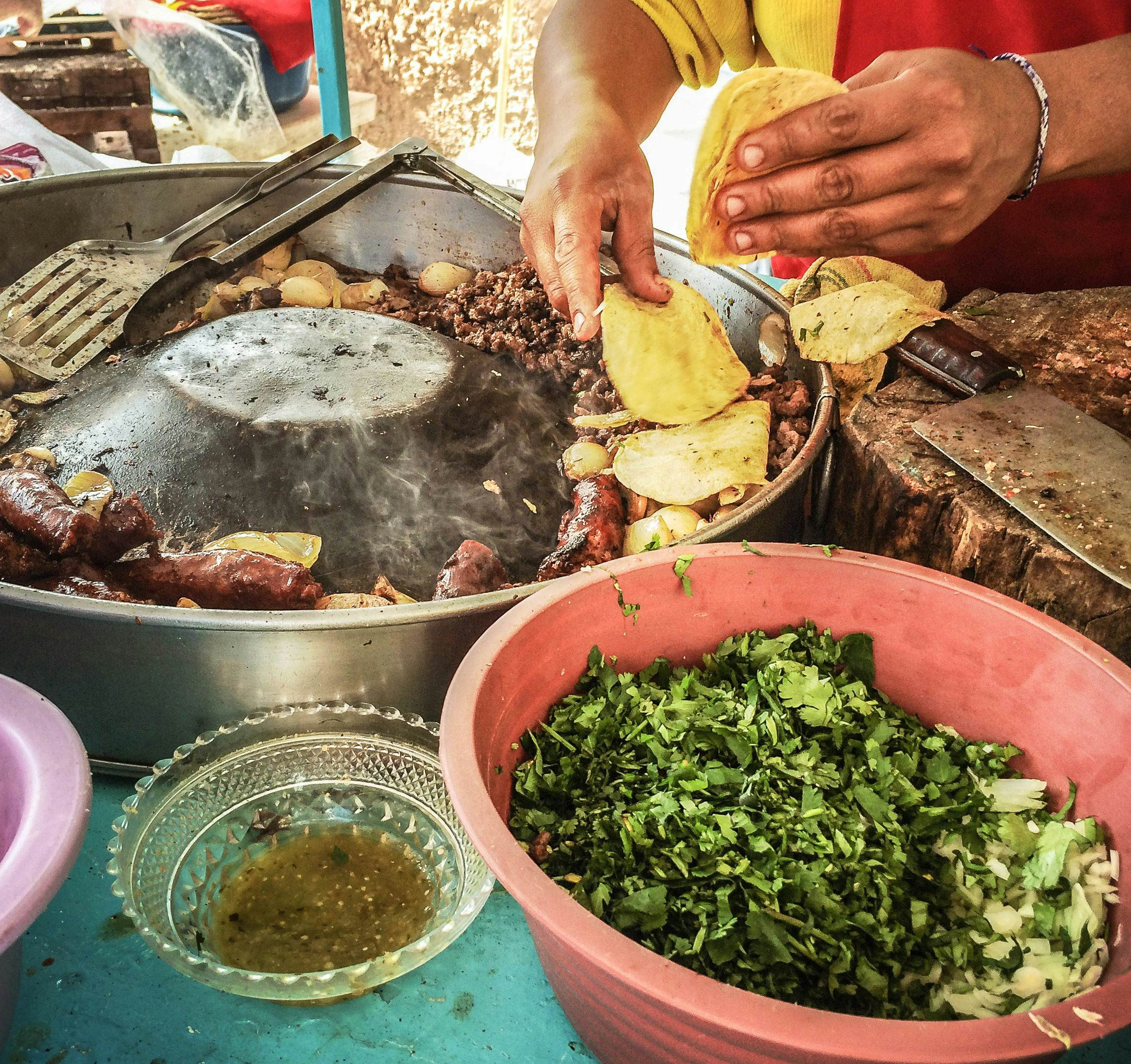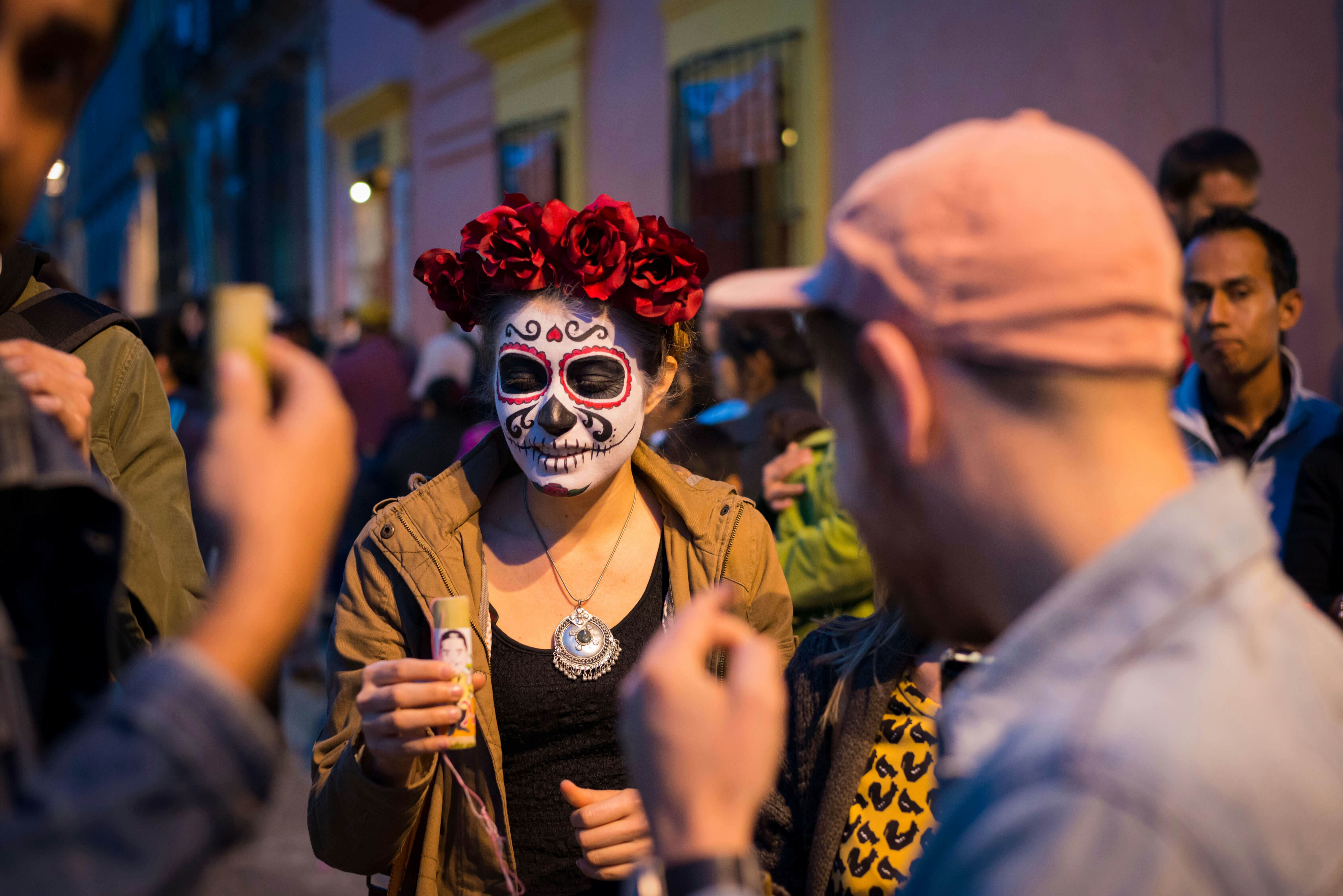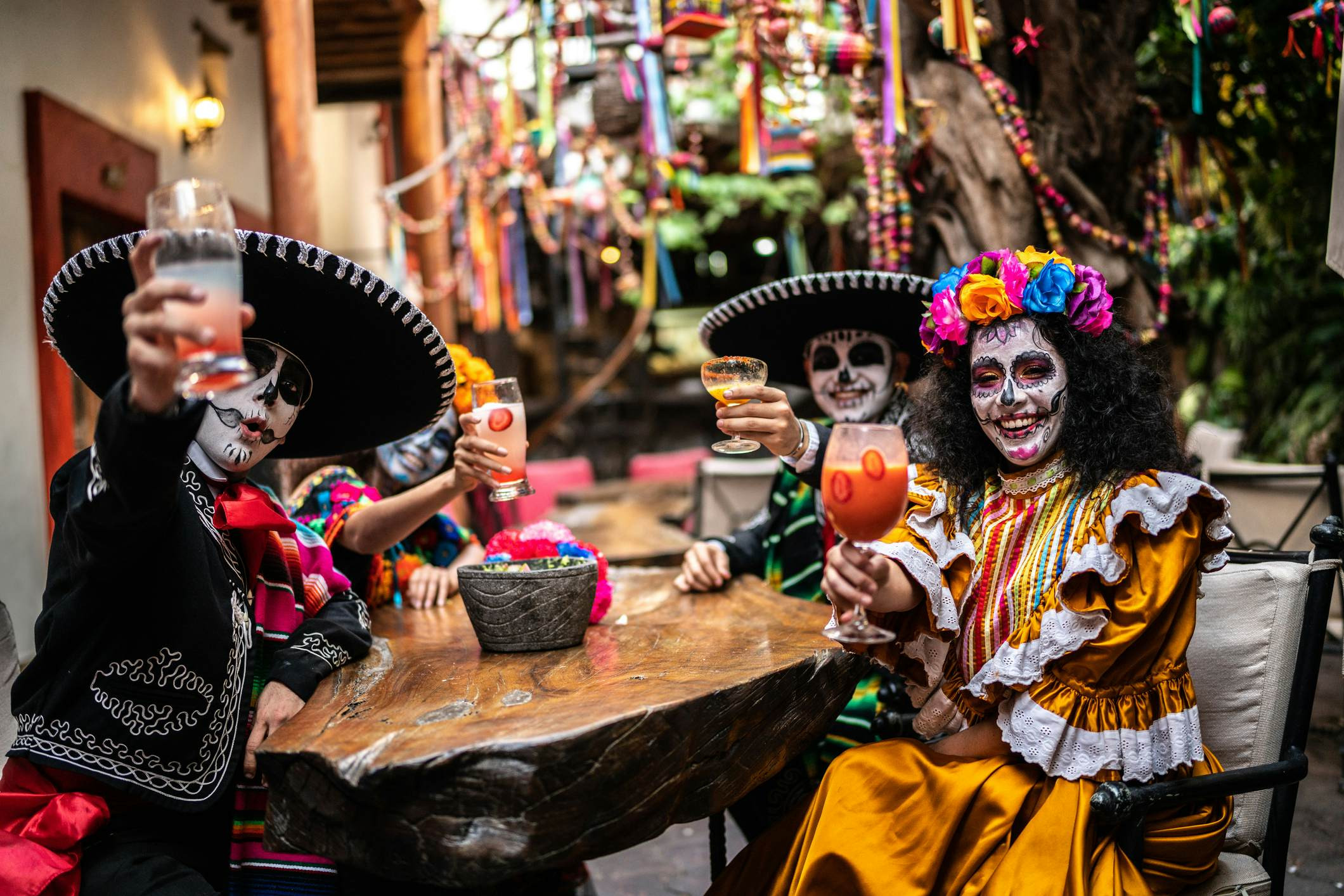What Happens On The Day Of The Dead In Mexico? Day of the Dead in Mexico is a vibrant and deeply meaningful celebration, honoring deceased loved ones with colorful traditions. Gaymexico.net serves as your ultimate resource to discover LGBTQ+ friendly events and destinations during this unique holiday and connect with the LGBTQ+ community. Discover the traditions, the destinations and celebrations.
1. What is Día de Muertos (Day of the Dead)?
Día de Muertos, or Day of the Dead, is a multifaceted Mexican celebration honoring deceased loved ones. Rooted in ancient indigenous beliefs and Catholic traditions, it focuses on remembering and celebrating the lives of those who have passed away. Rather than a somber occasion, it is a vibrant expression of love, remembrance, and the cyclical nature of life and death. According to research from the UCLA Williams Institute, cultural celebrations that embrace diversity and inclusivity foster stronger community bonds.
1.1 Why is Día de Muertos important to Mexican culture?
Día de Muertos is a cornerstone of Mexican identity. UNESCO recognizes its cultural importance. It serves as a profound reminder of the interconnectedness between the living and the dead. It is a time for families to come together, share stories, and keep the memories of their ancestors alive. This holiday emphasizes the cyclical nature of life and death. It provides a framework for understanding and accepting mortality.
1.2 How is Día de Muertos perceived outside of Mexico?
Outside of Mexico, Día de Muertos is often misunderstood or oversimplified. Many people view it as a “Mexican Halloween.” However, this comparison is inaccurate. Día de Muertos is not about fear or fright. It is about love, remembrance, and celebration. Its growing popularity has led to increased cultural awareness and appreciation. Many communities outside Mexico now host Día de Muertos celebrations to honor their own deceased loved ones.
2. When Does Día de Muertos Take Place?
Día de Muertos officially takes place on November 1st and 2nd. However, preparations and celebrations often begin in mid-to-late October. November 1st is Día de los Inocentes (Day of the Innocents) or Día de los Angelitos (Day of the Little Angels). It focuses on honoring children who have passed away. November 2nd is Día de los Muertos or Día de los Difuntos (Day of the Departed). It is dedicated to remembering adults who have died. The timing coincides with the Catholic holidays of All Saints’ Day and All Souls’ Day, blending indigenous and religious traditions.
2.1 What is the significance of November 1st (Día de los Inocentes)?
Día de los Inocentes, or Day of the Innocents, holds special meaning within Día de Muertos. It is a day dedicated to remembering children who have passed away. Families create special ofrendas (altars) with toys, candies, and other items that children would have enjoyed. This day acknowledges the pain of losing a child while celebrating their innocence and joy.
2.2 How does the celebration change from November 1st to November 2nd?
The focus shifts from children to adults. On November 2nd, families honor deceased adults. Ofrendas are modified to include items like tequila, cigarettes, and other adult favorites. Cemeteries become central to the celebration. Families gather to clean and decorate gravesites and share stories about their loved ones. The atmosphere is festive yet respectful, with music, food, and shared memories.
3. What Are Ofrendas (Altars) and Their Significance?
Ofrendas are central to Día de Muertos. They are altars set up in homes, businesses, and public spaces to honor deceased loved ones. Ofrendas can range from simple displays to elaborate multi-level arrangements. They typically include photos of the deceased, their favorite foods and drinks, and personal items that held significance for them. Candles, flowers, and religious symbols are common additions.
3.1 What items are commonly found on an ofrenda?
Common ofrenda items include:
- Photos of the deceased: To honor and remember them.
- Favorite foods and drinks: To nourish the spirits upon their return.
- Personal items: Like toys, books, or clothing, to evoke memories.
- Candles: To guide the spirits to the ofrenda.
- Flowers: Especially marigolds (cempasúchil), to attract the spirits with their color and scent.
- Papel picado: Colorful, perforated paper banners that symbolize the fragility of life.
- Sugar skulls: Decorated skulls made from sugar, representing the deceased.
- Salt: To purify the spirits.
- Water: To quench the spirits’ thirst after their journey.
3.2 How do ofrendas differ regionally in Mexico?
Regional variations in ofrendas reflect the diverse cultural traditions of Mexico. In Oaxaca, ofrendas may feature mole negro and other regional dishes. In Yucatán, calabaza en tacha (candied pumpkin) is a common offering. Coastal regions may include seafood and other maritime-themed items. Despite these differences, the underlying purpose of honoring and remembering the deceased remains consistent across all regions.
 Ofrendas are a focal point during Day of the Dead celebrations. Anton Romaniuk/Shutterstock
Ofrendas are a focal point during Day of the Dead celebrations. Anton Romaniuk/Shutterstock
Alt text: A vibrant Day of the Dead ofrenda displays photos, flowers, and food, honoring departed loved ones in a colorful and meaningful way.
4. How Do Cemeteries Transform During Día de Muertos?
Cemeteries become vibrant centers of activity during Día de Muertos. Families gather to clean and decorate gravesites with flowers, candles, and other offerings. The atmosphere is festive and respectful. Families bring food, drinks, and music to share with their deceased loved ones. Live music is common. Musicians wander through the cemeteries playing the favorite tunes of the deceased.
4.1 What is the atmosphere like in a cemetery during Día de Muertos?
The atmosphere in a cemetery during Día de Muertos is unique. It blends mourning with celebration. Families laugh, share stories, and reminisce about their loved ones. The air is filled with music, the scent of flowers, and the aroma of traditional foods. Cemeteries become temporary gathering places. They serve as a bridge between the living and the dead.
4.2 Are there regional variations in cemetery celebrations?
Regional variations in cemetery celebrations are common. In some areas, families spend the entire night in the cemetery. They keep vigil over the graves of their loved ones. In other regions, elaborate processions and ceremonies take place. These processions often include traditional music, dance, and costumes. Janitzio Island in Michoacán is renowned for its candlelit canoe procession.
 Gravesites illuminated by candlelight during Day of the Dead celebrations in San Andres. Shutterstock
Gravesites illuminated by candlelight during Day of the Dead celebrations in San Andres. Shutterstock
Alt text: Candlelit gravesites during Day of the Dead at San Andres, Mexico, create a serene and respectful ambiance.
5. What is the Significance of Cempasúchil (Marigolds)?
Cempasúchil, or marigolds, are the official flower of Día de Muertos. These bright orange flowers are native to Mexico. They have been used in Day of the Dead celebrations since ancient times. People believed that their vivid color and musky fragrance helped guide spirits back to their homes.
5.1 Why are marigolds considered the flower of the dead?
Marigolds are associated with the sun. Their vibrant color symbolizes life and light. Ancient beliefs held that the petals of marigolds contained the souls of the deceased. The strong scent of marigolds is believed to attract spirits. Their color and scent help guide them to the ofrendas.
5.2 How are marigolds used in Day of the Dead celebrations?
Marigolds are used extensively in Día de Muertos celebrations. They decorate ofrendas and gravesites. Petals are scattered along paths leading to the ofrendas. They create a fragrant trail for the spirits to follow. Marigolds are also used in wreaths and other floral arrangements. They add color and vibrancy to the celebrations.
6. What Traditional Foods Are Prepared for Día de Muertos?
Food is an essential part of Día de Muertos. Ofrendas feature the favorite foods of the deceased. They represent their preferences and different regional cuisines. Mole negro in Oaxaca, pozole in Mexico City, and calabaza en tacha in Yucatán are popular dishes. Pan de muerto (bread of the dead) is almost universally present. It is a spongy, egg-based bread sprinkled with sugar.
6.1 What is Pan de Muerto and its symbolism?
Pan de muerto (bread of the dead) is a quintessential Day of the Dead food. This sweet bread is typically flavored with anise and orange zest. It is decorated with bone-shaped dough and sprinkled with sugar. The round shape represents the cycle of life and death. The bone-shaped decorations symbolize the deceased. Bakeries start selling pan de muerto weeks before Día de Muertos. It is used on ofrendas and enjoyed with coffee, hot cocoa, or atole.
6.2 How do regional cuisines influence the food offerings?
Regional cuisines play a significant role in Día de Muertos food offerings. Each region showcases its unique culinary traditions. Oaxaca is known for its complex mole sauces. Yucatán features dishes with influences from Mayan culture. Central Mexico offers hearty stews like pozole. These regional variations reflect the diverse cultural heritage of Mexico.
 A street vendor prepares food for Day of the Dead celebrations in Mexico City. PamelaViola/Getty Images
A street vendor prepares food for Day of the Dead celebrations in Mexico City. PamelaViola/Getty Images
Alt text: A street vendor preps tasty treats in Mexico City for Día de Muertos.
7. What is La Catrina and Her Significance?
La Catrina is a high-society skeleton. She sports a feather boa and an oversized Victorian-era hat. José Guadalupe Posada created her in the early 1900s. She embodies the reality that death spares no one. The rich and poor alike are equal in death. Diego Rivera popularized her through his art. She has become a national symbol of Día de Muertos.
7.1 How did La Catrina become a symbol of Día de Muertos?
La Catrina originally satirized the Mexican elite who imitated European customs. Over time, she evolved into a symbol of Mexican identity. She is a reminder of mortality and the importance of embracing one’s heritage. Her image is prevalent in Día de Muertos celebrations. She represents the acceptance of death as a natural part of life.
7.2 How is La Catrina represented in modern celebrations?
La Catrina is represented in various forms during Día de Muertos. Paper mâché décor, candy skulls, and papel picado feature her image. People paint their faces to resemble her. They dress in Victorian-era finery or colorful regional costumes. Parades and processions often feature people dressed as La Catrina.
8. What Special Events Take Place During Día de Muertos?
Día de Muertos traditionally is family oriented. Larger-scale festivities are taking hold all over the country. These range from cemetery processions and city-wide parades to street fairs with food vendors and neon-lit rides. Standout celebrations include Mexico City’s Desfile de Alebrijes, Mixquic’s La Alumbrada, and Janitzio Island’s canoe procession.
8.1 Can you describe some of the most popular Day of the Dead events in Mexico?
Popular Day of the Dead events in Mexico:
- Mexico City’s Desfile de Alebrijes: A parade featuring fantastical creatures and elaborate floats.
- Mixquic’s La Alumbrada: The town goes dark. Thousands of candles light up the intricately adorned gravesites.
- Janitzio Island’s Canoe Procession: Flower-covered, candlelit canoes mark the start of a nightlong vigil/party at the town cemetery.
- Oaxaca City’s Week of Festivities: Includes dance and music performances, graveyard tours, and a “best altar” competition.
- Mérida’s Paseo de las Ánimas: A procession of people in skeleton face paint and traditional Yucatecan dress.
8.2 Are there LGBTQ+ friendly Día de Muertos celebrations?
Yes, various cities known for their welcoming LGBTQ+ communities host Día de Muertos events. Puerto Vallarta, Mexico City, and Guadalajara often have inclusive celebrations. These may include special ofrendas dedicated to LGBTQ+ individuals who have passed away. There are also performances and events that celebrate diversity and inclusion. Gaymexico.net is your resource for finding LGBTQ+ friendly events.
 Oaxaca City is one of the best places to take part in the Day of the Dead celebrations. Joel Carillet/Getty Images
Oaxaca City is one of the best places to take part in the Day of the Dead celebrations. Joel Carillet/Getty Images
Alt text: Day of the Dead celebrations in Oaxaca City, Mexico.
9. How Can LGBTQ+ Travelers Experience Día de Muertos?
LGBTQ+ travelers can experience Día de Muertos authentically. They can participate respectfully in the celebrations. Research LGBTQ+ friendly destinations and events. Engage with local communities. Be mindful of cultural sensitivities. Support businesses that promote diversity and inclusion. Gaymexico.net provides valuable resources and information for LGBTQ+ travelers.
9.1 What are some tips for LGBTQ+ travelers visiting Mexico during Día de Muertos?
Tips for LGBTQ+ travelers:
- Research LGBTQ+ friendly destinations: Cities like Puerto Vallarta and Mexico City are known for their welcoming communities.
- Plan accommodations and activities: Book hotels and tours that cater to LGBTQ+ travelers.
- Learn basic Spanish phrases: Knowing some Spanish can enhance your interactions with locals.
- Be aware of local customs: While Mexico is generally welcoming, being mindful of local customs is important.
- Connect with local LGBTQ+ organizations: They can provide insights and recommendations.
- Respect cultural traditions: Participate respectfully in Día de Muertos celebrations.
- Stay informed: Keep up-to-date on any travel advisories or safety concerns.
- Use Gaymexico.net: To find resources and information tailored for LGBTQ+ travelers.
9.2 What resources are available for LGBTQ+ travelers planning a Día de Muertos trip?
Resources for LGBTQ+ travelers include:
- Gaymexico.net: Provides information on LGBTQ+ friendly destinations, events, and businesses in Mexico.
- LGBTQ+ travel guides: Offer insights and recommendations for planning safe and enjoyable trips.
- Online forums and communities: Allow travelers to connect with others and share experiences.
- Local LGBTQ+ organizations: Provide information and support for visitors.
- Travel agencies: Specialize in LGBTQ+ travel and can help plan customized itineraries.
10. How Does Día de Muertos Promote Community and Remembrance?
Día de Muertos fosters community bonds. It reinforces the importance of remembrance. Families come together to honor their ancestors. They share stories and traditions. The celebrations create a sense of belonging and continuity. They connect generations and preserve cultural heritage.
10.1 How does Día de Muertos help families connect with their ancestors?
Día de Muertos provides a unique opportunity for families to connect with their ancestors. By creating ofrendas, visiting cemeteries, and sharing stories, families keep the memories of their loved ones alive. The celebrations serve as a reminder of the interconnectedness between the living and the dead. They reinforce the importance of family history and cultural heritage.
10.2 What role does Día de Muertos play in preserving Mexican cultural heritage?
Día de Muertos plays a vital role in preserving Mexican cultural heritage. The traditions, rituals, and symbols associated with the holiday have been passed down through generations. The celebrations reinforce the importance of indigenous beliefs and customs. They showcase the diversity and richness of Mexican culture. UNESCO recognizes the cultural importance of Día de Muertos.
11. What are the Current Trends in Día de Muertos Celebrations?
Día de Muertos celebrations are evolving. They are incorporating new elements while preserving traditional customs. Increased tourism has led to larger-scale events and commercialization. Social media has played a role in popularizing the holiday. Communities are finding creative ways to adapt and modernize the celebrations.
11.1 How is tourism impacting Día de Muertos celebrations?
Tourism has had a significant impact on Día de Muertos celebrations. It has brought increased attention and recognition to the holiday. Many communities now host larger-scale events to attract tourists. This has led to economic benefits. Concerns have been raised about the commercialization of the holiday. It is important to balance tourism with the preservation of cultural integrity.
11.2 How is social media influencing the way Día de Muertos is celebrated?
Social media has played a crucial role in popularizing Día de Muertos. Platforms like Instagram and Facebook showcase the vibrant colors, intricate ofrendas, and elaborate costumes. This has helped raise awareness and appreciation for the holiday. Social media allows people to share their own Día de Muertos experiences. It encourages participation and engagement.
12. What is the Significance of Sugar Skulls in Día de Muertos?
Sugar skulls are a prominent symbol of Día de Muertos. These colorful, decorated skulls are made from sugar. They represent the deceased. They are placed on ofrendas to honor and remember them. Sugar skulls often have the name of the deceased written on the forehead.
12.1 How are sugar skulls made and decorated?
Sugar skulls are made using a mold. A mixture of granulated sugar, water, and meringue powder is pressed into the mold. The skull is then allowed to dry and harden. Decorations are added using colorful icing, feathers, and other embellishments. The process is often a family affair. People create personalized sugar skulls for their loved ones.
12.2 What do sugar skulls symbolize in Día de Muertos?
Sugar skulls symbolize the deceased. They are a sweet and colorful reminder of those who have passed away. The decorations and personalized names show love and respect. Sugar skulls represent the acceptance of death. They are a natural part of life. They are a celebration of the lives of those who are no longer with us.
13. What is the Role of Papel Picado in Día de Muertos?
Papel picado (perforated paper) is a traditional Mexican folk art. It is a decorative element in Día de Muertos celebrations. These colorful paper banners are cut with intricate designs. They depict skeletons, flowers, and other Day of the Dead motifs. Papel picado symbolizes the fragility of life. It adds color and vibrancy to the celebrations.
13.1 How is papel picado made?
Papel picado is made by folding tissue paper in layers. Artisans use chisels and hammers. They cut intricate designs into the paper. The process requires skill and precision. The results are delicate and beautiful banners. They add a festive touch to Día de Muertos celebrations.
13.2 What does papel picado symbolize in Día de Muertos?
Papel picado symbolizes the fragility of life. The delicate paper represents the fleeting nature of existence. The intricate designs represent the beauty and complexity of life. The banners flutter in the wind. It reminds us of the ever-present cycle of life and death.
14. How Can You Respectfully Participate in Día de Muertos?
Participating respectfully in Día de Muertos is essential. It shows appreciation for Mexican culture. Avoid cultural appropriation. Learn about the traditions and customs. Engage with local communities. Be mindful of your behavior in cemeteries and other sacred spaces. Support local businesses that promote cultural preservation.
14.1 What is cultural appropriation and how can it be avoided during Día de Muertos?
Cultural appropriation is the adoption of elements of a minority culture by members of the dominant culture. It can be harmful. It often trivializes or distorts the original meaning. To avoid cultural appropriation during Día de Muertos, educate yourself about the holiday’s history and significance. Do not wear costumes or makeup. They mock or disrespect the traditions. Engage with local communities. Support cultural preservation efforts.
14.2 What are some Do’s and Don’ts for visitors during Día de Muertos celebrations?
Do’s:
- Do learn about the history and significance of Día de Muertos.
- Do participate respectfully in celebrations.
- Do engage with local communities.
- Do support local businesses.
- Do be mindful of your behavior in cemeteries and sacred spaces.
- Do ask questions and show genuine interest in the traditions.
Don’ts:
- Don’t wear costumes or makeup that mock or disrespect the traditions.
- Don’t treat Día de Muertos as a party or excuse for excessive drinking.
- Don’t take photos without asking for permission.
- Don’t touch or disturb ofrendas without permission.
- Don’t be disrespectful or disruptive in cemeteries.
- Don’t perpetuate stereotypes or misconceptions about Mexican culture.
15. Where Can You Find More Information About Día de Muertos?
More information about Día de Muertos can be found through various sources. Museums, cultural centers, and libraries offer exhibits and educational programs. Online resources provide articles, videos, and interactive content. Travel guides and blogs offer insights and recommendations for experiencing Día de Muertos. Gaymexico.net provides information tailored for LGBTQ+ travelers.
15.1 What are some reliable sources for learning about Día de Muertos?
Reliable sources for learning about Día de Muertos include:
- Museums and cultural centers: Offer exhibits and educational programs.
- Academic articles and books: Provide in-depth research and analysis.
- Documentaries and films: Offer visual insights into the traditions.
- Reputable travel guides and blogs: Provide practical information and recommendations.
- Government websites: Offer official information and resources.
- Gaymexico.net: A valuable resource tailored for LGBTQ+ travelers.
15.2 How can Gaymexico.net help with planning a Día de Muertos trip?
Gaymexico.net provides LGBTQ+ travelers with essential information. It includes LGBTQ+ friendly destinations and events in Mexico. The website offers tips and recommendations. It ensures a safe and enjoyable Día de Muertos experience. Gaymexico.net connects travelers with local LGBTQ+ communities. It allows travelers to support businesses that promote diversity and inclusion.
Address: 3255 Wilshire Blvd, Los Angeles, CA 90010, United States.
Phone: +1 (213) 380-2177.
Website: gaymexico.net.
 Preparations for the Day of the Dead can start as early as October. FG Trade Latin/Getty Images
Preparations for the Day of the Dead can start as early as October. FG Trade Latin/Getty Images
Alt text: Preparations begin for Day of the Dead as early as October, showcased by vibrant market displays in Mexico.
FAQ About Día de Muertos
1. What is the origin of Día de Muertos?
Día de Muertos has roots in ancient indigenous beliefs from the Toltecs and Aztecs. They believed the spirits of the dead returned once a year. Spanish colonizers incorporated Catholic traditions.
2. Is Día de Muertos a sad occasion?
No, Día de Muertos is not a sad occasion. It is a celebration of life and remembrance of loved ones who have passed away.
3. What is the significance of ofrendas?
Ofrendas are altars. They honor deceased loved ones. They include photos, favorite foods, and personal items.
4. Why are cemeteries decorated during Día de Muertos?
Cemeteries are decorated to welcome the spirits of the deceased. Families clean and decorate gravesites with flowers and candles.
5. What is the role of marigolds in Día de Muertos?
Marigolds are considered the flower of the dead. Their vibrant color and scent guide spirits back to their homes.
6. What is pan de muerto?
Pan de muerto is a sweet bread. It is traditionally eaten during Día de Muertos. It symbolizes the cycle of life and death.
7. Who is La Catrina?
La Catrina is a high-society skeleton. She symbolizes that death spares no one.
8. Are there special events during Día de Muertos?
Yes, there are special events. These are parades, processions, and street fairs. They celebrate Día de Muertos.
9. How can LGBTQ+ travelers experience Día de Muertos respectfully?
LGBTQ+ travelers should research LGBTQ+ friendly destinations and events. Engage with local communities, and be mindful of cultural sensitivities.
10. Where can I find more information about Día de Muertos?
You can find more information at museums, cultural centers, and online resources like Gaymexico.net.
Ready to experience the magic of Día de Muertos in Mexico? Visit gaymexico.net now for LGBTQ+ travel guides, event listings, and community connections! Explore safe and welcoming destinations, discover vibrant celebrations, and honor the traditions of this unforgettable holiday. Start planning your adventure today and create memories that will last a lifetime!